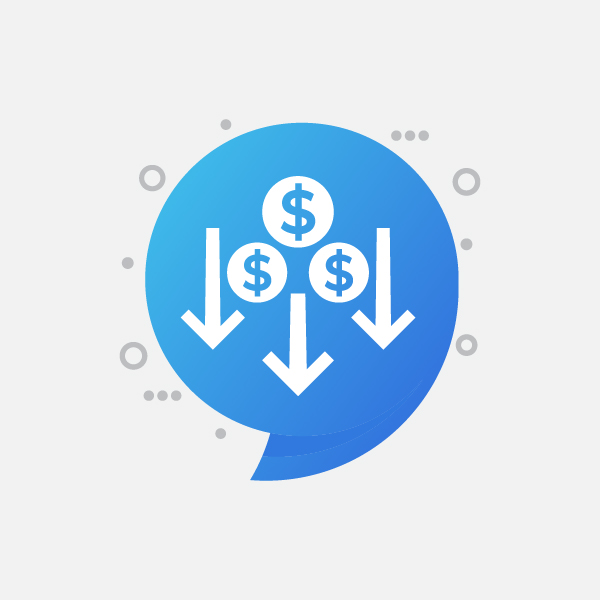
FINANCIAL WELLNESS
Financial wellness: A glossary of terms for beginners
Feb 02, 2023
Navigating the world of finance as a beginner can be overwhelming, especially when you encounter terms you’ve never heard before. So, we created a list of common definitions to give you a foundation as you embark on your financial wellness journey.
Nothing serves as procrastination bait more than finances. It's dull, it's complicated, and it's hard to know where to start. On the other hand, mastering your finances is an accomplishment that pays you back in a variety of ways, from helping you achieve your life goals to reducing your stress levels.
If your ultimate goal is financial wellness and all the benefits that come with it, getting there starts with taking the first step. This article is here to help you understand some common finance terms that leave our heads spinning, so you can start your journey to educating and empowering yourself to tackle your finances.
Personal equity is calculated by deducting liabilities from assets to get your personal net worth. This would look something like:
Inflation is the rate at which prices rise for goods and services. This rate is commonly affected by money supply, wage increases or decreases, supply chain, and the status of the economy itself. The opposite of inflation is deflation, where prices for goods and services can decrease.
There are usually specific terms assigned to the loan agreement, such as interest rate, length of term, and if the rate is fixed or variable, meaning the rate is either stagnant or in constant flow based on the fluctuation of the economy.
Cash flow is essentially the amount of money that is moving in and out, whether that is a personal cash flow or the cash flow of a company. Either way, it’s the same principle.
An important tool for maintain positive cash flow is a budget. Here are three great budgeting frameworks are:
Emergency funds help with financial security by planning for the unknown, and it’s never too early to start one, and no amount is too small to make a difference. An easy way to contribute to this safety net is by setting up an auto-transfer from each paycheck to go into an emergency savings bucket.
For example, if your gross pay is $30,000 and your total deductions are $9,000, your net pay would be $21,000.
Examples of loans that are not amortized are credit cards or loans with a variable interest rate.
If you’re just starting out on your financial wellness journey, understanding common terms is a great place to start. Once you do, you’ll have a solid foundation to continue your financial education and build the skills you need to empower yourself.
A great next step is to find your budgeting style and start saving. Learn how to make saving on a budget easy to see what style might be right for you.
Please note, this content is for informational purposes only and should not be construed as professional or financial advice.
If your ultimate goal is financial wellness and all the benefits that come with it, getting there starts with taking the first step. This article is here to help you understand some common finance terms that leave our heads spinning, so you can start your journey to educating and empowering yourself to tackle your finances.
Here’s what we’ll cover:
- What is a beneficiary?
- What is cash flow?
- What is a co-buyer?
- What is a co-signer?
- What is a credit score?
- What is debt-to-income ratio (DTI)?
- What is a dependent?
- What is an emergency fund?
- What is equity?
- What is an individual retirement account (IRA)?
- What is inflation rate?
- What is interest?
- What is a loan amortization?
- What is loan to value ratio?
- What is net pay?
- What is a Roth IRA?
- What is a 401(k)?
PERSONAL FINANCE
What is equity?
Personal equity is calculated by deducting liabilities from assets to get your personal net worth. This would look something like:Equity = Assets (cash, savings, investments, material goods) - Liabilities (loans, bills, mortgage, etc.)
What is inflation rate?
Inflation is the rate at which prices rise for goods and services. This rate is commonly affected by money supply, wage increases or decreases, supply chain, and the status of the economy itself. The opposite of inflation is deflation, where prices for goods and services can decrease.What is interest?
Interest is a monetary sum earned by lenders for their services. When borrowing money, such as taking out a loan, using a credit card, or signing a mortgage, there is an interest rate attached where the borrower pays an ongoing fee, the interest, to the lender. This is a “there’s no such thing as free” phenomenon, where the lending party is compensated for taking on the risk of an individual using or borrowing funds that are owned by the lender.There are usually specific terms assigned to the loan agreement, such as interest rate, length of term, and if the rate is fixed or variable, meaning the rate is either stagnant or in constant flow based on the fluctuation of the economy.
BUDGETING
What is cash flow?
Cash flow is essentially the amount of money that is moving in and out, whether that is a personal cash flow or the cash flow of a company. Either way, it’s the same principle.More money flowing in versus out = positive cash flow
More money flowing out versus in = negative cash flow
More money flowing out versus in = negative cash flow
An important tool for maintain positive cash flow is a budget. Here are three great budgeting frameworks are:
- Values-based budgeting: A great framework to learn how to be more intentional with spending
- Zero-based budgeting: This framework calls upon financial wellness seekers who are detail oriented
- 50/30/20 budgeting: A budget framework based on allocation of your income
What is an emergency fund?
An emergency fund is a financial safety net that people can rely on if an unexpected expense or emergency were to occur, such as an unexpected healthcare cost. How would you pay for this if you didn’t previously budget for it? By dipping into your emergency fund.Emergency funds help with financial security by planning for the unknown, and it’s never too early to start one, and no amount is too small to make a difference. An easy way to contribute to this safety net is by setting up an auto-transfer from each paycheck to go into an emergency savings bucket.
What is net pay?
Net pay is the amount of an individual’s total earnings that ends up in their pocket. That means, taxes, contributions, and deductions have already been removed. Gross pay is your total earnings before any deductions, contributions, and taxes are taken out.For example, if your gross pay is $30,000 and your total deductions are $9,000, your net pay would be $21,000.
Net pay = gross income – total deductions
Net pay = $30,000 - $9,000
Net pay = $21,000
Net pay = $30,000 - $9,000
Net pay = $21,000
LENDING
What is a co-buyer?
When a borrower – someone who is signing a loan or any type of financing agreement, like a mortgage – has a co-buyer, both of their names go on title. They can combine credit scores and incomes to help qualify for the agreement, and both are responsible for payment.What is a co-signer?
When a borrower has a co-signer, only the primary borrower is on title, not the co-signer. The co-signer helps the borrower by signing and contributing their good credit to help the borrower qualify. Similar to a co-buyer, if the borrower misses a payment, it then defaults to the co-signer to pay. Otherwise, both of their credit scores can be affected.What is a credit score?
When applying for a loan or a mortgage, a credit score may be used by lenders to evaluate the likelihood that the borrower will pay back a loan within the agreed upon timeline. Each score is based on credit history, for example, history of debt accumulation and timely payments made, and current debt to date. The credit score number ranges between 300 and 850.What is debt-to-income ratio (DTI)?
A debt-to-income ratio (DTI) is similar to credit score, as it is also used by lenders to determine the repayment risk level of a borrower. However, in the case of using a DTI ratio, the lower the percentage the better the borrowing candidate ranks. This percentage is determined by comparing an individual’s monthly total debt and gross income.DTI = total debt / gross income
DTI = $1,000 / $4,000
DTI = 25%
DTI = $1,000 / $4,000
DTI = 25%
What is loan amortization?
Loan amortization is when a loan is scheduled into equal payments with a fixed interest rate. This sets up the loan to be paid off over a specified timeline, which provides a clear structure to the borrower on how to make payments. A loan of this type can be set up as an auto-payment, if your bank allows, since it is the same contribution amount every payment.Examples of loans that are not amortized are credit cards or loans with a variable interest rate.
What is the loan-to-value ratio?
Loan-to-value (LTV) ratio is a measurement used to assess the qualification of a mortgage loan. The ratio compares the loan amount to the value of the home. A low loan-to-value ratio is favorable as it confirms to the lender there is less risk involved with the agreement. A high loan-to-value ratio may put the qualification of the mortgage loan in jeopardy as it represents a higher risk to the lender.
BENEFITS
What is a beneficiary?
A beneficiary is the person who receives financial assets when the owner of those assets passes away. Financial assets should be assigned a beneficiary to allow everything to be distributed according to the passed individual’s requests.What is a dependent?
A dependent is a qualifying individual whom another individual provides for. Commonly, this could be a child or a relative who qualifies under the specified taxpayer requirements of a dependent. There can be some tax benefits associated with having a qualified dependent. Make sure to check out the IRS FAQ before listing a dependent, to confirm that qualifications have been met.What is an individual retirement account (IRA)?
An individual retirement account, often referred to as an IRA, is a savings account intended for future use that comes with specific tax benefits. This type of long-term savings account can be opened through a bank or a broker. An IRA is an attractive retirement planning option for individuals who do not have access to employer retirement benefits, such as those who are self-employed. Often, IRAs can also be used in conjunction with employer retirement plans to provide additional savings opportunities.What is a Roth IRA?
A Roth individual retirement account (IRA) is a special type of IRA that enables you to potentially save on taxes while putting money away for retirement. The simplest way to think about a Roth IRA is this: you put your after-tax money into your Roth IRA and then you don’t pay any further taxes on that contribution. This means the money you contribute can grow tax-free and you can make tax-free withdrawals once you’ve reached a certain age. As of 2023, you must be 59 1/2 to withdraw from your Roth IRA and have had the account for more than five years.What is a 401(k)?
A 401(k) is a retirement savings account that is generally set up by your employer as part of your employee benefits plan. Typically, the employee signs up for the 401(k) plan, and a set amount is deducted from each paycheck and transferred into the 401(k) account. Some employers even go a step further by matching all or a portion of the employees’ contributions. This means the employer would contribute a set amount to the employee’s 401(k) account in addition to the employee’s own contributions.Next steps to financial wellness
If you’re just starting out on your financial wellness journey, understanding common terms is a great place to start. Once you do, you’ll have a solid foundation to continue your financial education and build the skills you need to empower yourself.
A great next step is to find your budgeting style and start saving. Learn how to make saving on a budget easy to see what style might be right for you.
Please note, this content is for informational purposes only and should not be construed as professional or financial advice.
RECOMMENDED FOR YOU

GETTING PAID
How to improve your Dayforce Wallet security

THE ART OF SAVING
Creative ways to spend less

FINANCIAL WELLNESS

